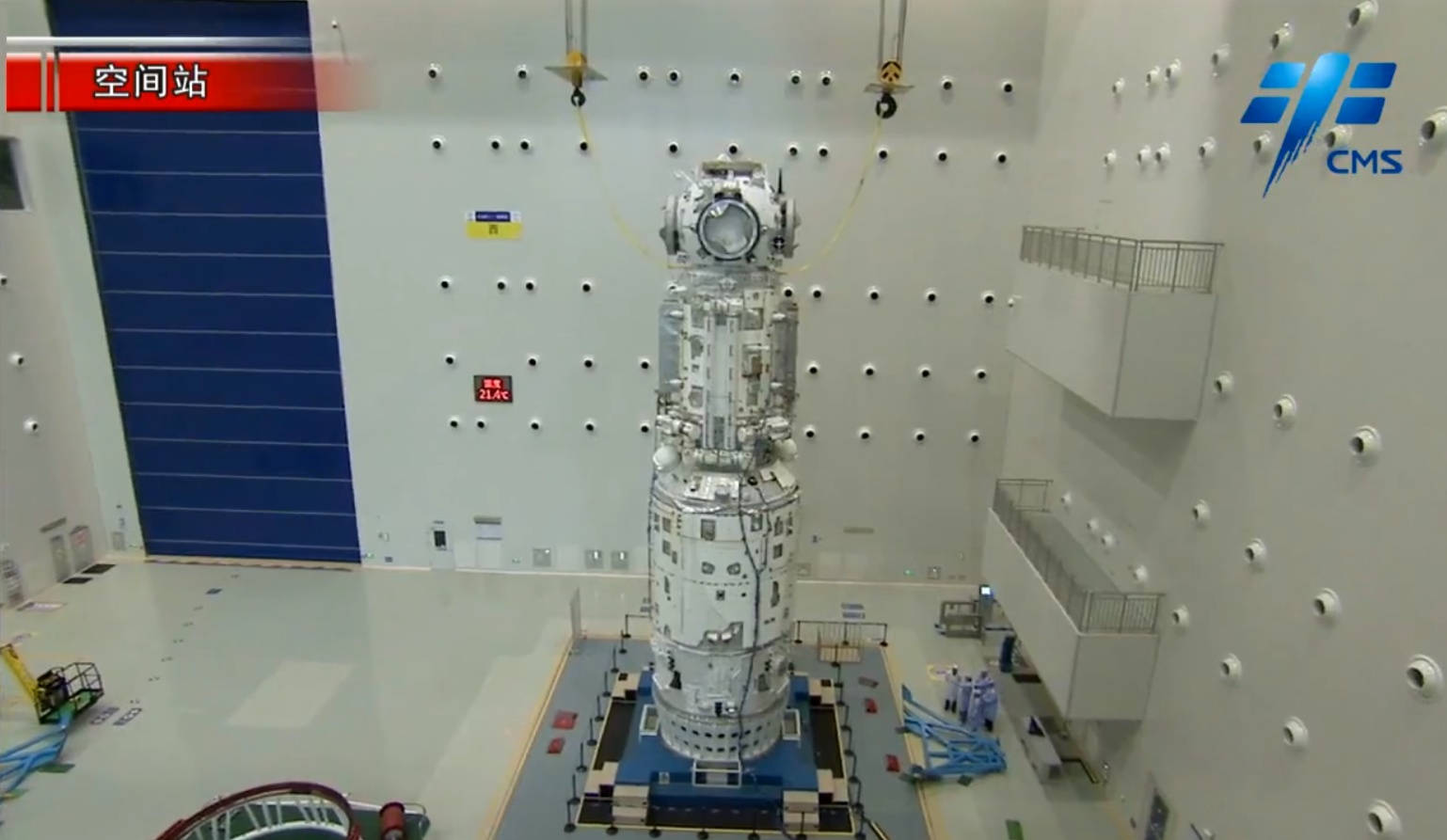China launches core module of new space station to orbit
The construction of China's space station is underway.
The core element of the Chinese Space Station launched to Earth orbit tonight (April 28), lifting off at 11:23 p.m. EDT (0323 GMT on April 29) atop a heavy-lift Long March 5B rocket from the Wenchang Spacecraft Launch Site on the island of Hainan.
The 54-foot-long (16.6 meters) module, known as Tianhe ("Harmony of the Heavens"), is the first space station component to launch. It will be joined in low Earth orbit later by two slightly smaller elements, forming a T-shaped space station that China aims to complete by the end of 2022.
But Tianhe will see considerable action far before then: A Chinese cargo spacecraft is expected to visit the module next month, and three astronauts will come aboard in June, if all goes according to plan.
Related: The latest news about China's space program
The road to Tianhe
China began laying the foundation for today's launch a decade ago. In September 2011, the nation launched a prototype space lab called Tiangong 1, to continue building its human spaceflight skill set and test the technologies needed to assemble and maintain a large space station in Earth orbit.
The uncrewed Shenzhou 8 spacecraft docked autonomously with Tiangong 1 in November 2011. Then, in June 2012, Shenzhou 9 carried three astronauts to the space lab for a two-week stay. A year later, three more crewmembers visited Tiangong 1 for two weeks on the Shenzhou 10 mission. (The Shenzhou program had three crewed orbital human spaceflights under its belt before the Tiangong 1 visits, sending astronauts aloft in 2003, 2005 and 2008.)
Breaking space news, the latest updates on rocket launches, skywatching events and more!
No crewed craft darkened Tiangong 1's door after that. But China launched a second space lab, Tiangong 2, in September 2016. The next month, Shenzhou 11 sent three astronauts to Tiangong 2, and this time they stayed aboard for a month.
In April 2017, the uncrewed Tianzhou 1 cargo vessel docked with Tiangong 2 and refuelled the space lab. Tianzhou 1 repeated this docking-refueling dance two more times over the next five months, showcasing capabilities that come in quite handy for space station operators.
Neither Tiangong 1 nor Tiangong 2 remains aloft. The first space lab fell to Earth in an uncontrolled fashion in April 2018, burning up over the southern Pacific Ocean. But China maintained control over Tiangong 2 to the end, guiding the craft to its demise in July 2019, also over the South Pacific.
Related: China selects 18 new astronauts in preparation for space station launch
A new research station in Earth orbit
When it's up and running, the Chinese Space Station will be just 20% as massive as the International Space Station (ISS), which would tip the scales at about 460 tons here on Earth. And, whereas the ISS routinely accommodates six or seven astronauts at a time, China's version is expected to host three-person crews.
But China plans to cram a lot of research activity into this smaller package. For example, the station will feature 14 internal experiment racks and more than 50 external docking points for instruments designed to gather data in the space environment, Scientific American reported recently.
The Chinese station's managers have already selected about 100 experiments to conduct on the craft, and some of them could start gathering data as soon as next year, Scientific American reported.
Not all of these investigations will be performed by Chinese scientists. Nine international experiments have already been selected to fly on the station through a program run jointly by the United Nations Office for Outer Space Affairs and the China Manned Space Agency, and more such solicitations are expected in the future.
None of those nine research projects are based in the United States, which isn't terribly surprising. U.S. law prohibits NASA and the White House Office of Science and Technology Policy from cooperating with their Chinese counterparts on space-related activities, unless Congress has granted approval of such cooperation in advance. This prohibition, which has been in place since 2011, is known as the Wolf Amendment after its champion, former Rep. Frank Wolf (R-Virginia).
And China is not a partner in the ISS consortium, which is led by the space agencies of the U.S., Russia, Europe, Japan and Canada.
China also plans to launch a powerful space telescope in 2024. The observatory will occupy an orbit similar to that of the space station, Chinese officials have said, allowing the scope to be refuelled, upgraded and maintained relatively efficiently.
There's a precedent for such on-orbit work; NASA astronauts serviced the Hubble Space Telescope during five space shuttle missions from 1993 to 2009. But each time, they had to launch to Hubble from Earth; there was no nearby space station to serve as a staging facility. (Hubble flies about 90 miles, or 150 kilometers, higher than the ISS, which began hosting astronauts continuously in November 2000.)
Mike Wall is the author of "Out There" (Grand Central Publishing, 2018; illustrated by Karl Tate), a book about the search for alien life. Follow him on Twitter @michaeldwall. Follow us on Twitter @Spacedotcom or Facebook.

Michael Wall is a Senior Space Writer with Space.com and joined the team in 2010. He primarily covers exoplanets, spaceflight and military space, but has been known to dabble in the space art beat. His book about the search for alien life, "Out There," was published on Nov. 13, 2018. Before becoming a science writer, Michael worked as a herpetologist and wildlife biologist. He has a Ph.D. in evolutionary biology from the University of Sydney, Australia, a bachelor's degree from the University of Arizona, and a graduate certificate in science writing from the University of California, Santa Cruz. To find out what his latest project is, you can follow Michael on Twitter.


